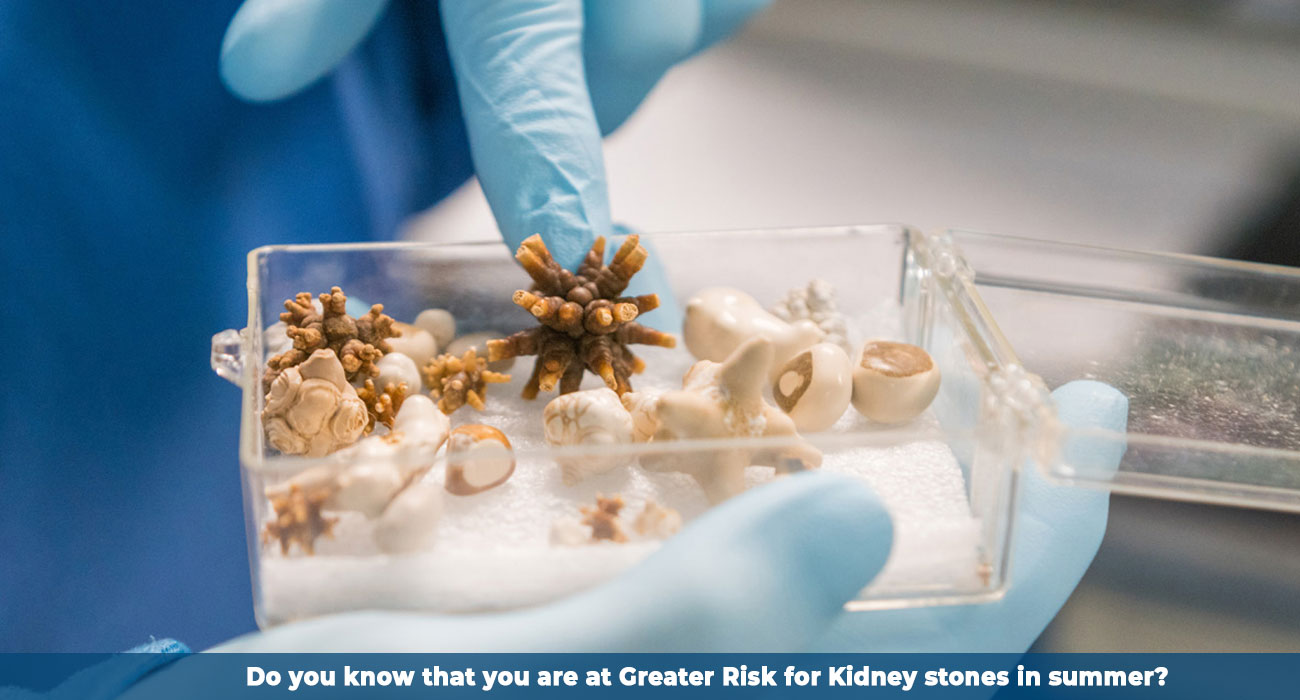Do you know that you are at Greater Risk for Kidney stones in summer?
08/02/2021
The scorching heat has come up again, and the kidney stone season began a couple of weeks ago. Usually, doctors see an increase in kidney stones when the weather heats up. Kidney stones are defined as solid irregularly-shaped formations composed of mineral and acid salts. When these kidney stones travel into the ureter, which is the tube linking the kidney and bladder, it results in excruciating lower back pain and groin discomfort.
You should consult a Nephrologist doctor in Jaipur about your kidney stones, treatment options, and how to decrease your risk of getting them.
- Seasonal shifts: Summer months are notorious for the rise of kidney stones in patients. These kidney stones usually occur in the summer months than in winter. If you are wondering the reason behind it, it is that because kidney stones are predominantly calcium-based, and our body develops more calcium in the urine in the winter, which raises the chance of kidney stones.
Excess calcium is the reason behind of developing kidney stones. If you are physically active, then that can protect you from stone development. People are usually inactive in winter, and thus more kidney stones are added in the bladder. Therefore, when the warm weather comes up, increased temperatures and dehydration result in further growth of the stones that are formed over the winter months and start moving suddenly.
These kidney stones will hit your right when you least expect it. If you plan to go to the park or plan to play some strenuous game, you may find out that the stone is actually there.
If you have kidney stones, visit the best Urology Surgery hospital in India for treatment.
- Seeking Relief: According to the National Institute of Diabetes and Digestive and Kidney Diseases, more than 3 million people visit a urologist annually for kidney stones. Kidney stones cause pain because our ureter, which is only 2 to 3 mm wide, attempts to squeeze and contract the stone through into the bladder as it feels blocked. You can experience nausea, vomiting, severe stabbing discomfort in the lower back, and/or groin because the ureter kidney builds up the pressure and stretches.
Kidney stones are present in various sizes ranging from as small as a grain of that of a golf ball, and it affects men and women equally. A smaller stone can easily pass through the urinary tract without medical treatment. You may also experience fever and chills, bloody urine, nausea, vomiting as well as a constant urge to urinate when the kidney stones are on the move.
Depending on your kidney stone's size, the doctor from Best Kidney Hospitals in India can provide recommendations as to whether you go for surgery or let it pass through medications. If surgery is involved, then there are several minimally invasive options depending on the stone's size and location.
How to Prevent Kidney Stones
If you had a kidney stone once, then there is a 50% chance of you developing another one within the next five years. There is a considerable risk that increases as you get older. Though you can’t completely prevent the kidney stones, you can do various things to decrease your risk.
Start by eating more fruits and vegetables, which will be helpful in making your urine less acidic and also decreasing the risk of stones formation. You should also avoid salt intake as this reduces the calcium in the urine. Work on those foods which have low sodium content and look out for various alternatives. You can avoid salty foods such as packaged meals, canned items, and snacks such as potato chips.
You can visit the Best hospital in Rajasthan to talk to a doctor or dietitian about diet changes if you are at considerable risk for kidney stones. Also, drink enough water at least 2.5 liters of urine per day during the summer season. This will help in diluting dilute your urine and reducing the formation of crystals such as calcium oxalate.

